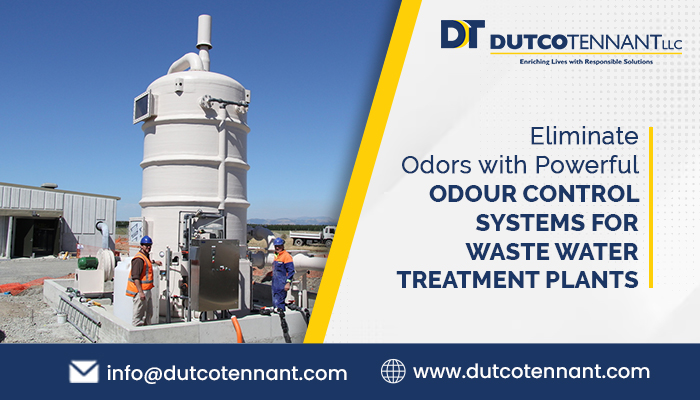
The activities involved in wastewater treatment plants helps control the wastage of water and contribute towards recycling efforts. However, what about the control over odour that emits as a result of various treatment processes occurring within the facility.
Well, this is why most wastewater treatment plants have dedicated odour control units to limit the release of foul and toxic odour. A lot of planning goes into the set up of an odour control unit. However, proper installation leads to intended results which is to keep the foul odour in check.
In this blog, we will be exploring the importance of odour control units, their functioning, and the various techniques used for mitigating odours in wastewater treatment plants.
Odour Control Units & Understanding Its Need in Wastewater Treatment Plants
Wastewater treatment plants (WWTP) are vital infrastructures designed to process large volumes of sewage and wastewater. However, the treatment process often generates foul-smelling gases, such as hydrogen sulphide (H2S), ammonia (NH3), and volatile organic compounds (VOCs).
These odorous emissions can create significant issues for nearby communities, plant workers, and the overall quality of life in the area. With the use of an odour control system, a WWTP meets the following requirements.
Community Impact
Odorous emissions from wastewater treatment plants can cause nuisance complaints from residents living in close proximity. Unpleasant smells can permeate residential areas, businesses, and public spaces, leading to discomfort, reduced property values, and overall dissatisfaction within the community. These issues can strain relationships between the plant and the surrounding population, necessitating the implementation of effective odour control measures.
Health Risks
Odorous compounds emitted by wastewater treatment plants may pose potential health risks to both workers and residents. Prolonged exposure to certain gases, such as hydrogen sulphide, can result in various health conditions, including respiratory problems, headaches, nausea, and in extreme cases, even neurological effects. As a responsible facility, it is essential to prioritise the health and well-being of those who live and work near the treatment plant.
Regulatory Compliance
Local environmental regulations and permits often stipulate limits for odour emissions from wastewater treatment plants. Failure to meet these regulations can result in fines, penalties, or even legal action against the facility. Therefore, implementing effective odour control measures is crucial to ensure compliance and maintain a good standing with regulatory agencies.
Environmental Impact
Odorous emissions from wastewater treatment plants can have adverse effects on the environment. Some compounds, such as VOCs, can contribute to air pollution and the formation of smog, negatively impacting air quality. Additionally, the release of odorous gases into the atmosphere may disturb the ecological balance in the surrounding area, affecting flora, fauna, and sensitive ecosystems. Implementing odour control units helps minimise these environmental impacts and supports the overall sustainability of the facility.
Key Functions Performed by Odour Control Units
Odour control units employ different technologies to capture, treat, and disperse odorous gases. The primary components of these units include:
a) Collection Systems: These systems gather odorous gases from the treatment process through ductwork, hoods, and vents.
b) Treatment Systems: Once collected, the odorous gases are subjected to various treatment techniques, such as adsorption, absorption, chemical scrubbing, biofiltration, or thermal oxidation. These processes aim to remove or neutralise the odorous compounds effectively.
c) Monitoring Systems: Odour control units are equipped with monitoring systems to continuously measure and analyse the concentration of odorous gases. This helps operators to adjust treatment parameters and ensure optimal performance.
d) Exhaust Systems: After treatment, the gases are released through exhaust stacks, ensuring that the emissions meet regulatory standards and are significantly reduced in terms of odour concentration.
Common Techniques Used for Odour Treatment
Now the real work happens during the treatment process within an odour control unit. There are many odour control technologies Dubai and in other locations, some of the common ones are:
a) Adsorption: Adsorption is a process where odorous gases pass through a medium like activated carbon. The medium works to trap the odour molecules. This technique is effective for removing VOCs.
b) Absorption: Absorption involves dissolving odorous gases into a liquid scrubbing solution, usually water or chemicals, to remove them from the air. Common absorption systems include packed towers and spray towers.
c) Chemical Scrubbing: Chemical scrubbing utilises chemicals like sodium hypochlorite, hydrogen peroxide, or potassium permanganate to chemically react with odorous compounds and convert them into less odorous or non-odorous substances.
d) Biofiltration: Biofiltration employs microorganisms that work to naturally break down odorous compounds. The odorous gases are passed through a biofilter, which contains a bed of organic material (e.g., compost or wood chips) inhabited by bacteria and fungi that consume the odorous compounds.
e) Thermal Oxidation: Thermal oxidation involves subjecting odorous gases to high temperatures in a combustion chamber to convert them into carbon dioxide and water vapour. This technique is particularly effective for high-concentration odour streams.
Conclusion
Odour control units are indispensable components of wastewater treatment plants. They play a significant role in mitigating the release of foul odours and improving the quality of life for surrounding communities.
By employing a combination of collection, treatment, monitoring, and exhaust systems, these units effectively reduce odorous emissions. The choice of odour control techniques depends on the specific characteristics of the plant and the odorous compounds involved.
If you are looking for a reliable supplier of odor control solutions in UAE then you can reach out to Dutco Tennant LLC. They have an extensive range of products and trusted assistance to help out large-scale projects.